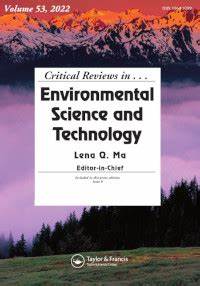The impact of functional additives on biodegradable plastic biodegradation in natural terrestrial and composting environments
IF 13.2
1区 环境科学与生态学
Q1 ENVIRONMENTAL SCIENCES
Critical Reviews in Environmental Science and Technology
Pub Date : 2025-05-19
DOI:10.1080/10643389.2024.2443284
引用次数: 0
Abstract
Biodegradable plastics show promise in addressing traditional plastic waste issues. However, most commercially available biodegradable plastic products are blended/composite materials, combining biodegradable polymers with other polymers, fillers and additives. Non-reactive functional additives, such as plasticizers and stabilizers, raise concerns due to potential leaching as well as release on degradation. Thus, understanding how these additives affect biodegradation rates and processes is crucial, and a comprehensive overview is missing in the literature. This review highlights that the localized additive concentration levels adjacent to the plastic materials could, at least for a time, exceed the threshold concentrations for substantial impacts on microbial activities, especially in slow transport media such as soil and compost. Of the available literature, it is concerning that only a small fraction reported continuous quantitative biodegradation data with sampling frequency and duration adequate for comprehensive data synthesis. In those studies, the presence of additives resulted in an extended lag time for biodegradation compared to virgin polymer. Interestingly, additives also typically increased the biodegradation rate following this initial lag time. Overall, variation was observed in the half-life of biodegradable polymer/additive blends when considering both lag time and biodegradation rate. The likely key controlling factors dictating how additives impact biodegradable plastics biodegradation include the rate of additive leaching, alterations in polymer properties induced by additives and their leaching, and the intrinsic characteristics of the additives themselves. Future life cycle analysis and environmental impact assessments of new bioplastic products must consider the influence of additives.功能添加剂对天然陆生和堆肥环境下生物降解塑料的影响
可生物降解塑料有望解决传统的塑料垃圾问题。然而,大多数市售的可生物降解塑料产品是混合/复合材料,将可生物降解聚合物与其他聚合物、填料和添加剂结合在一起。非反应性功能添加剂,如增塑剂和稳定剂,由于潜在的浸出和降解释放而引起关注。因此,了解这些添加剂如何影响生物降解速率和过程是至关重要的,文献中缺乏全面的概述。本综述强调,至少在一段时间内,塑料材料附近的局部添加剂浓度水平可能超过对微生物活动产生重大影响的阈值浓度,特别是在土壤和堆肥等缓慢运输介质中。在现有文献中,令人担忧的是,只有一小部分报告了连续的定量生物降解数据,采样频率和持续时间足以进行全面的数据合成。在这些研究中,与原始聚合物相比,添加剂的存在导致生物降解的滞后时间延长。有趣的是,添加剂通常也增加了初始滞后时间后的生物降解率。总的来说,考虑到滞后时间和生物降解率,生物可降解聚合物/添加剂共混物的半衰期发生了变化。决定添加剂如何影响可生物降解塑料生物降解的可能关键控制因素包括添加剂浸出速率、添加剂及其浸出引起的聚合物性质的改变以及添加剂本身的内在特性。未来新型生物塑料产品的生命周期分析和环境影响评价必须考虑添加剂的影响。
本文章由计算机程序翻译,如有差异,请以英文原文为准。
求助全文
约1分钟内获得全文
求助全文
来源期刊
CiteScore
27.30
自引率
1.60%
发文量
64
审稿时长
2 months
期刊介绍:
Two of the most pressing global challenges of our era involve understanding and addressing the multitude of environmental problems we face. In order to tackle them effectively, it is essential to devise logical strategies and methods for their control. Critical Reviews in Environmental Science and Technology serves as a valuable international platform for the comprehensive assessment of current knowledge across a wide range of environmental science topics.
Environmental science is a field that encompasses the intricate and fluid interactions between various scientific disciplines. These include earth and agricultural sciences, chemistry, biology, medicine, and engineering. Furthermore, new disciplines such as environmental toxicology and risk assessment have emerged in response to the increasing complexity of environmental challenges.
The purpose of Critical Reviews in Environmental Science and Technology is to provide a space for critical analysis and evaluation of existing knowledge in environmental science. By doing so, it encourages the advancement of our understanding and the development of effective solutions. This journal plays a crucial role in fostering international cooperation and collaboration in addressing the pressing environmental issues of our time.

 求助内容:
求助内容: 应助结果提醒方式:
应助结果提醒方式:


